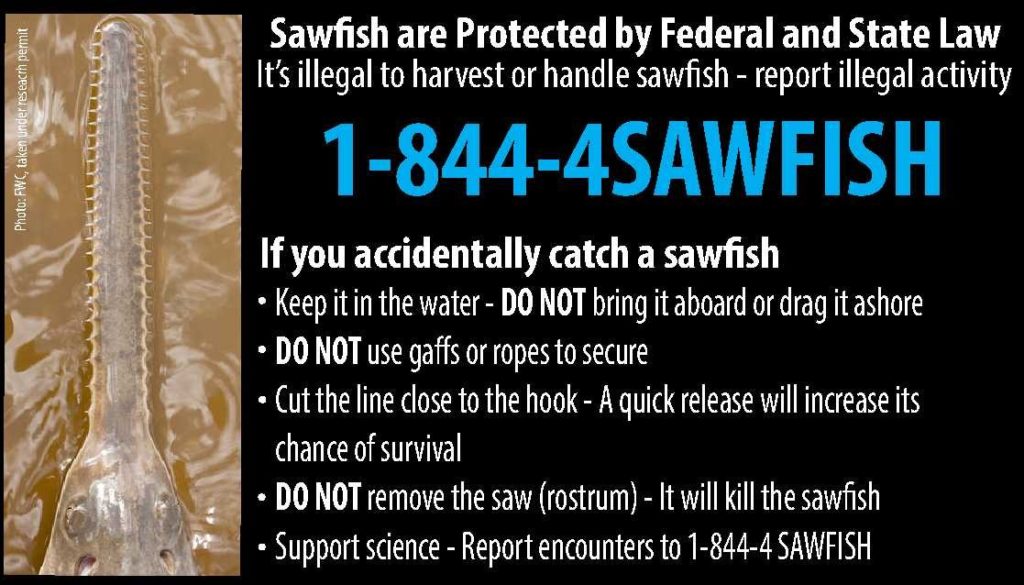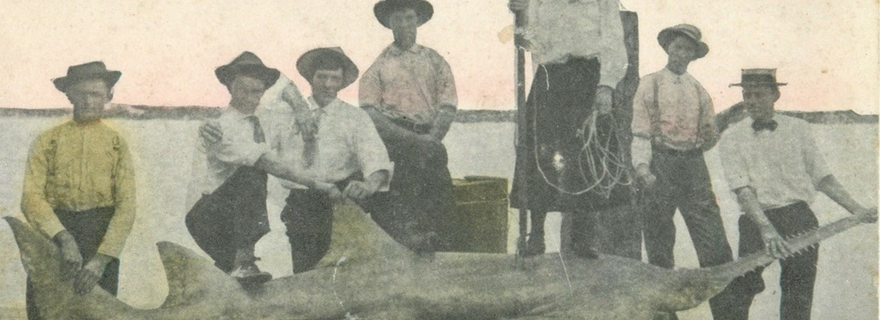
by Tonya Wiley, Havenworth Coastal Conservation
Smalltooth sawfish — a nearly iconic subject of fishing photos over the last two centuries — may be making a comeback in Tampa Bay. Five have been reported in recent months in locations ranging from Anna Maria north to Honeymoon and in the Manatee River.
“They’re still very rare, but it’s promising that we’re hearing about them more and more often,” notes Adam Brame, who heads sawfish recovery efforts at the National Oceanic and Atmospheric Administration in St. Petersburg. “A lot of the problems that have killed them in the past — particularly gillnets– aren’t allowed in the bay so we’re hopeful that we’ll see more.”

The fish seen locally have been mostly young adults or larger juveniles, indicating that the bay is not yet supporting a breeding population of smalltooth sawfish, he adds. “We’re asking fishermen who see or inadvertently catch a sawfish to report it, so we can monitor sawfish presence within the Bay.” (More information on how to release an endangered sawfish is available at the end of the article.)
A research project is currently underway to tag sawfish in Tampa Bay, gather information on historical and current catches, collect small samples from historical sawfish rostra (saws) in public and private collections for genetic analysis, and give public presentations about sawfish in the United States.
 Their odd appearance and awesome size once made them a prized catch for recreational fishermen. Their unique elongated, blade-like snouts, studded with teeth on both sides– scientifically known as a rostrum — were often kept as trophies. Net fishermen, on the other hand, considered them a serious nuisance because of the damage they could cause to their gear.
Their odd appearance and awesome size once made them a prized catch for recreational fishermen. Their unique elongated, blade-like snouts, studded with teeth on both sides– scientifically known as a rostrum — were often kept as trophies. Net fishermen, on the other hand, considered them a serious nuisance because of the damage they could cause to their gear.
Two species of sawfish were once found in the U.S.: the largetooth sawfish, Pristis pristis, and the smalltooth sawfish, Pristis pectinata. The largetooth sawfish was found throughout the Gulf of Mexico but was more common in western Gulf waters of Texas and Mexico. The smalltooth sawfish ranged from Texas to New York and was most plentiful in the eastern Gulf waters of Florida, including Tampa Bay. Both sawfish species were considered “abundant” and “common” in the early 1900s. Numerous postcards, photographs, and newspaper articles from that era document fishermen hauling countless sawfish to boats, docks, and beaches across the country.
Unfortunately, the largetooth sawfish has not been seen in the U.S. since 1961. The smalltooth sawfish has fared better and still remains in U.S. waters, though at greatly reduced numbers and geographic range. Today, the smalltooth sawfish is found predominantly in southwest Florida from Charlotte Harbor to the Keys, including Everglades National Park. The vast expanse of natural habitat within the park and limited fishing pressure likely served as a refuge for sawfish.
Like many aquatic animals, smalltooth sawfish declined because of overfishing, habitat loss and low reproductive potential. Born live at about two feet long, juvenile sawfish rely on very shallow, coastal and estuarine waters close to shore for safety from predators, such as sharks, during the first years of their lives. They take many years to reach sexual maturity, and produce very few offspring per reproductive cycle, making it difficult for them to maintain their populations.
Due to the dramatic decline of the sawfish populations, the smalltooth sawfish was classified as endangered in 2003, making it the first fully marine fish and first elasmobranch (sharks, skates, and rays) protected by the Endangered Species Act. The largetooth sawfish was listed as endangered in 2011.
Will sawfish in the United States recover? Unfortunately, the largetooth sawfish is probably locally extinct and gone for good from U.S. waters. Researchers are hopeful that education — particularly on safely releasing sawfish — protection from fishing and minimizing habitat loss will help the smalltooth sawfish return to its natural range.
Tonya Wiley is a fisheries biologist who conducted research on smalltooth sawfish for Mote Marine Laboratory and then established Havenworth Coastal Conservation in Palmetto to protect imperiled marine species through research, outreach and education and is leading the project to study the sawfish of Tampa Bay. She is a member of the National Marine Fisheries Service’s Smalltooth Recovery Implementation team, a multi-institutional panel of experts working to protect the remaining sawfish population in the US and prevent the species from going extinct. You can follow Havenworth Coastal Conservation on Facebook and Twitter for updates from the field. She also is available for presentations on sawfish to groups and organizations. She can be reached at Tonya@havenworth.org or 941-201-2685.
For information on smalltooth sawfish recovery planning or to report rostrum for genetic sampling, please visit https://www.fisheries.noaa.gov/species/smalltooth-sawfish
 Educating fishermen to protect smalltooth sawfish
Educating fishermen to protect smalltooth sawfish
With sawfish protected under the Endangered Species Act, it’s illegal for anyone to possess one. However, they’re occasionally caught on a hook by a fisherman targeting other species.
Unlike the recommendations for releasing most fish, fishermen should not try to remove the hook, Brame said. Sawfish mouths are located under their sharp-toothed rostrum and removing the hook could cause serious damage to both the fish and the fishermen.
If you catch or see a smalltooth sawfish, take a quick photograph of it, estimate its size, note your location, and share the information. The details of your sightings or catches help scientists studying the endangered species track recovery progress and target their field surveys. You can share your information by calling 1-844-4-SAWFISH (1-844-472-9347).
Published February 7, 2018
